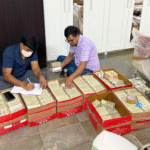Big Boost for Mumbai Metro: 4 New Lines and One Unified Travel App to Transform Commute
Mumbai’s Transit Evolution
Mumbai, India’s financial capital and one of the most densely populated cities in the world, has always been in a race against time and space when it comes to urban mobility. For decades, the city relied heavily on its lifeline—the suburban railway network—an extensive, overcrowded, and aging system. As population growth, commercial expansion, and urban sprawl intensified, the need for a modern, integrated, and efficient public transport system became critical.
In response, the Mumbai Metro project was envisioned as a comprehensive mass rapid transit solution designed to alleviate the burden on local trains, reduce traffic congestion, and provide Mumbaikars with a faster and more comfortable travel experience. While the existing Metro Lines 1 and 2A brought limited relief, the next stage of the city’s transportation evolution has now arrived: an ambitious expansion featuring four new Metro lines and a unified travel app.
The new developments signify not just an infrastructural leap but a major shift in urban planning philosophy, focusing on sustainability, accessibility, and digital convenience. This long-form article explores the various facets of this transformation in a detailed, human-centered, and thoroughly professional narrative.
Overview of the New Metro Lines
The addition of four new lines—Metro Lines 4, 5, 6, and 9—marks a historic acceleration in Mumbai’s infrastructure upgrade. These corridors are not only set to ease pressure on arterial roads and existing railways but also extend the Metro’s reach into under-connected zones, thus enhancing equity in urban mobility.
- Metro Line 4 (Wadala–Kasarvadavali): Spanning over 32 kilometers with more than 30 stations, this line will link central Mumbai with the Thane district. It is expected to cut down travel time between Wadala and Thane by more than 50%, benefiting daily commuters and reducing vehicular emissions.
- Metro Line 5 (Thane–Bhiwandi–Kalyan): Often regarded as the industrial spine of the MMR (Mumbai Metropolitan Region), this corridor will provide an eco-friendly transit solution to a heavily populated and commercially vital belt.
- Metro Line 6 (Swami Samarth Nagar–Vikhroli): This east-west corridor will relieve some of the pressure from the JVLR (Jogeshwari-Vikhroli Link Road), one of the busiest and most congested stretches in the city.
- Metro Line 9 (Dahisar East–Mira Bhayandar): With this extension, commuters from northern suburbs will find better connectivity to the Western Express Highway and the upcoming coastal road project.
Together, these four lines are expected to carry over 2 million passengers daily by 2030, a number that reflects both the potential and the necessity of such expansive development.
The Unified Travel App – A Digital Backbone for Commuters
While physical infrastructure lays the foundation, digital innovation completes the journey. The newly announced unified travel app is designed to bring together Metro services, local trains, BEST buses, and even auto/taxi aggregators onto a single platform. With a focus on user convenience and real-time data integration, this app represents a leap toward smart city functionality.
Key features of the app include:
- Real-time updates on train and bus schedules.
- Digital ticketing with QR codes for seamless gate access.
- Multi-modal journey planning based on shortest travel time or least cost.
- Integrated payments supporting UPI, credit/debit cards, and metro smartcards.
- Crowd density indicators for planning safer and more comfortable travel.
The app also aims to be inclusive, supporting multiple languages and accessibility features for differently-abled commuters.
Such an initiative not only reduces reliance on fragmented third-party apps but also aligns with the Digital India vision by enhancing governance, transparency, and commuter empowerment.
Overcoming Engineering and Logistical Challenges
Building a mass rapid transit network in a megacity like Mumbai is no small feat. The topography, densely packed urban clusters, and high traffic zones present significant engineering and logistical hurdles. However, each challenge has also become a learning curve for authorities, engineers, and workers involved in the Metro expansion.
Land Acquisition and Urban Congestion: Land acquisition has been one of the most contentious issues during the expansion. With space already at a premium in Mumbai, the authorities had to walk a tightrope between development and displacement. Several stations had to be redesigned to minimize property acquisition and avoid demolition of heritage structures. Innovative underground tunneling techniques and elevated track systems have allowed planners to work around some of the city’s most congested areas.
Environmental Considerations: The Mumbai Metro expansion had to adhere to rigorous environmental regulations. This includes tree transplantation, water conservation measures during construction, and sustainable design practices for stations. Noise and air pollution controls have also been enforced, with dust management systems and noise barriers deployed extensively across sites.
Technical Milestones and Delays: Despite the best efforts, timelines have seen inevitable delays due to COVID-19 disruptions, monsoonal impacts, and labor shortages. However, breakthroughs in TBM (Tunnel Boring Machine) technology and modular station construction methods have helped recover time lost. The use of prefabricated segments and digital twin technology has further enhanced precision, safety, and efficiency.
Workforce Management and Safety: Thousands of engineers, project managers, and workers operate across multiple sites simultaneously. Stringent safety protocols and round-the-clock monitoring are in place to ensure both worker welfare and timely progress. The workforce also includes skilled professionals trained under government skill development programs, creating jobs while upgrading urban infrastructure.
As these lines inch closer to operational status, the behind-the-scenes coordination—between civic authorities, international consultants, private contractors, and public stakeholders—underscores the massive scale and complexity of what is being accomplished.
Anticipated Economic Impact and Urban Transformation
The expansion of the Mumbai Metro system is more than a transport project—it is a transformative economic catalyst for the city and its adjoining regions. As the new lines edge closer to completion, urban planners, economists, and policy experts are assessing the widespread ripple effects this infrastructure upgrade is expected to unleash across multiple sectors.
1. Real Estate Upliftment and Zonal Appreciation:
One of the most immediate and visible impacts of metro connectivity is its effect on real estate. Historically, areas surrounding metro stations have witnessed significant appreciation in property values. With the launch of Metro Lines 4, 5, 6, and 9, new neighborhoods—from Kasarvadavali and Kalyan to Mira Bhayandar and Vikhroli—are poised for transformation.
Developers have already begun investing in these transit-oriented development (TOD) zones. Affordable housing is expected to flourish alongside premium residential and commercial real estate. In turn, this helps decongest saturated localities like Andheri, Bandra, and Dadar, redistributing economic activity more evenly across the MMR.
2. Job Creation and Economic Multiplier Effect:
The construction and operations of the new metro lines have already generated thousands of direct jobs—ranging from civil engineers and architects to daily wage laborers and security personnel. But the long-term multiplier effect is far more substantial. Retail outlets, food courts, last-mile transport providers, and digital service vendors in and around metro stations are all expected to benefit from the surge in footfall.
Additionally, MSMEs in peripheral zones, previously held back by poor connectivity, will find easier access to talent pools and customers. This infrastructural push has the potential to decentralize Mumbai’s economic model—encouraging satellite townships and reducing dependency on central business districts.
3. Reducing Productivity Loss Due to Traffic:
Mumbai’s traffic congestion is not just a civic nuisance—it represents billions of rupees lost annually due to delays, fuel wastage, and health costs. The new metro corridors are projected to collectively save the city over 120 million commuter hours per year. This regained time translates directly into improved productivity, enhanced work-life balance, and better mental health outcomes for millions.
Fewer cars on the road also mean reduced demand for fuel, lesser maintenance costs for vehicles, and a dramatic decline in the number of road accidents. All of these bring down costs for both the government and citizens.
4. Boost to Tourism and Business Travel:
A world-class metro network helps rebrand Mumbai as a truly global city. Tourists, delegates, and business travelers often cite transportation woes as a major drawback when visiting. With direct metro access to major hubs—airports, business parks, entertainment zones, and heritage sites—Mumbai is likely to see a jump in both domestic and international visitor satisfaction.
Metro integration with airports (like the planned Metro Line 8 connecting the Chhatrapati Shivaji Maharaj International Airport to Navi Mumbai Airport) is a game-changer for logistics and convenience. It brings Mumbai one step closer to matching the efficiency of international metropolises like Singapore, Tokyo, and London.
5. Enabling Gender-Inclusive and Safer Travel:
Mumbai’s metro systems are widely regarded as safer and more gender-inclusive compared to other public modes. The enhanced network, when operational, is expected to empower more women to travel independently and access job opportunities farther from home. The presence of women-only coaches, CCTV-monitored compartments, uniformed guards, and better lighting further ensures a more secure environment.
This directly contributes to higher female labor force participation and increased economic independence, particularly among women from low-income communities who earlier relied on slow and unsafe options.
Also Read : Liquor Scam Shocker: ₹11 Crore Cash Seized from Guesthouse in Massive Raid






